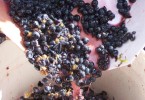Clinto wine: the history of a forbidden wine
Origin and rules of Clinto wine
People say that everything we like is either illegal, immoral or fattening. This is the case of Clinto grapes that reached the Old Continent from America, around 1820. It is obtained thanks to the direct cross between Vitis riparia and Vitis labrusca. Clinto variety is thus, a hybrid direct product, not grafted, characterized by a great resistance to the illness and the phylloxera. In Veneto it is well known with the name of Clintòn (Crinto, Grintón or U Grintu).
Actually, Clinto is pretty different from Clinton and many wine estimators consider it better and with a sweeter taste. Arrived in Italy, as solution of the problems of the vineyards, it caused several problems, before with the powdery mildew, then with the downy mildew and the phylloxera (an insect of the family of Phylloxerae), starting to threaten our vineyards.
For this reason, on 23rd March 1931, the Law n. 376 was issued: it forbid both the cultivation and the sell of the grapes produced by hybrid grape variety. This ban was addressed in particular to wine Clinto and Bacò. Then, the 2nd of April of 1936, with the Law n. 729, the ban included also the to the vine variety Isabella (used to produced Fragolino). It was allowed just the cultivation of this wines with the aim to be consumed directly by the producer, but it wasn’t like this…
On February 12th of 1965, the art. 22 of D.P.R n.162 states the Vitis Vinifera, as the only plant to obtain the wine, excluding the wine Clinto and the others (Bacò and Francolino). The Regulations n. 822 of 1987 and n. 1493 of 1999, requiring the european rules to come into force. They states that they have to be uproot. Exception for those varieties of grapes addressed to the family consumption.
2. Characteristics and expansion on the territory

After the last laws, Clinto wine has almost disappeared from the Italian tables, remaining however in their mind. It is possible to find Clinto vineyards around Italy, cultivated with care by nostalgic producers that sell appreciate its particular organoleptic properties.
A great part of this vineyards is located in Veneto, above all in the area of Vicenza. In Villaverla, there is a fest that, each year in Villa Ghellini, celebrates this wine: here they prize the best wine produced with Clinto grape variety, then it is possible to taste typical products cooked with this wine and grapes. Some people say that the choice to forbid the production of this wine is given by the necessity to eliminate the competition, this grape variety coming from America can reduce the quality of our wines, favoring an overproduction of bad wines.
Actually, the high content of tannins and its peel, rich in substances potentially toxic, make it a danger for the human health if it is consumed in high quantities.
In fact, if it is treated in the wrong way, the wine produced with Clinto grape has a high quantity of methanol. How to recognize the forbidden wine? Its taste is unique: intense, acid and raw, with a strong and wrapping perfume. Its red colour, very dark, almost violet, it leaves its traces on the glasses, on the bottles and it spot everything. This colour is so intense that neither the digestion can change it.
3. Clinto, the unknown
The law forbid to produce this wine to sell it, but this doesn’t stop the lovers to drink it. The truth is that, neither in Italy nor in America, there have been cases of poisoning because of this wine. Paying attention to drink it in small quantities, anyone can taste it, unique in its category.
For this reason, it is easy to find wine produced with Clinto grape almost all over Europe, especially in the north of Europe, cultivated outside the market.
Images source: fitisafeministissue.com, clintonvineyards.com







